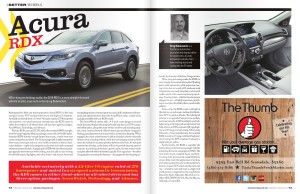Acura RDX
Whiz-bang technology aside, the 2016 RDX is a very straight-forward vehicle to pilot, says auto writer Greg Rubenstein.
Redesigned for 2016, the third-generation Acura RDX is a five-seat compact luxury SUV with loaded with luxury and high-tech features. Available exclusively with a 3.5-liter V6 engine rated at 279 horsepower and mated to a six-speed automatic transmission, the RDX comes in either front-wheel or all-wheel-drive and has three option packages: AcuraWatch, Technology, and Advance.
The base RDX starts at $35,270, while the reviewed AWD example, with the range-topping Advance package comes with a $43,420 sticker. Standard RDX features include heated front seats, a multi-view rear camera and power rear hatch. The Tech package adds in eight-way power front seats, blind spot and rear cross traffic monitors as well as dual-screen displays—eight-inch navigation and a seven-inch dash-mounted infotainment touchscreen. Equipping the RDX with the Advance package upgrades the front seats with cooling, and also adds in rain-sensing windshield wipers, fog lights, auto-dim driver’s side mirror, front and rear parking sensors, remote engine start and a full complement of driver-assist and safety functions from the AcuraWatch suite, a stand-alone package available with any RDX model.
The AcuraWatch option adds a 4.2-inch center gauges-mounted multi-function display with programmable trip data and GPS navigation information, along with state-of-the-art driver aids including adaptive cruise control, forward collision warning and collision mitigation braking, lane departure warning as well as assisted lane keeping. When engaged, the cruise control system is able to maintain a driver-selectable distance from a leading vehicle, while the lane keeping system actively steers the vehicle to maintain position between lane lines. It’s not quite autonomous driving, as the driver still has to provide steering input in response to anything more than a gentle curve, but the system works exceptionally well within its limited capacity. Turn signal use—for either changing lanes or exiting the freeway—disengages the lane keeping system for the duration of the lane change or turn.
Whiz-bang technology aside, the RDX is a very straight-forward vehicle to pilot. Braking feel is stable and secure, while suspension tuning is firm but not overly stiff; moderate road irregularities are easily absorbed, and smooth roads reward with a serene motoring experience. Steering input—whether lane keeping is engaged or not—is highly responsive, providing an everyday drivability that is comfortably athletic.
From a stop, the RDX scoots to 60 mph in the mid six-second range, making this diminutive SUV as quick as it looks. The redesigned exterior is an upgrade from previous models, and now includes LED headlights and taillights along with improved aerodynamics that help achieve an EPA-estimated 28 mpg highway and 19 mpg city fuel rating. After nearly 500 miles of real-world driving, the sampled RDX turned in 23 mpg combined highway/city, besting the EPA combined rating by a single mile per gallon.
Aesthetically, the RDX is arguably the best-looking of all Acura’s passenger vehicles (excepting the exotic and gorgeous NSX). The new, lower hood, sculpted fascia and fenders along with pronounced, angled belt-line creases help create the appearance of motion, even when parked. If you’re in the market for a luxury compact SUV, check out this new cute ‘ute—it holds its own and more as a high-tech and luxurious competitor to the Land Rover Discovery Sport, Mercedes-Benz GLC, Cadillac SRX, BMW X1/X3, Porsche Macan, Audi Q5, or Lexus RX.
Available exclusively with a 3.5-liter V6 engine rated at 279 horsepower and mated to a six-speed automatic transmission, the RDX comes in either front-wheel or all-wheel-drive and has three option packages: AcuraWatch, Technology, and Advance.
Related posts
Leave a Comment
You must be logged in to post a comment.







